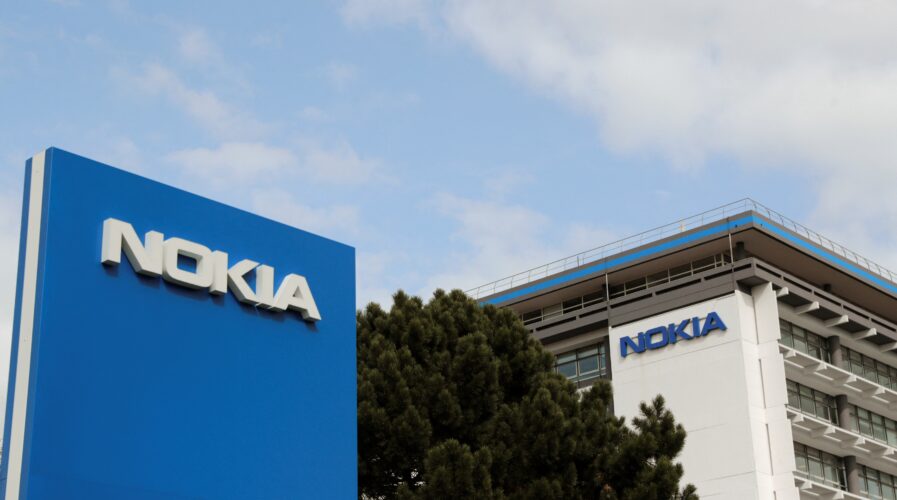
Nokia: Cloud native architecture critical to 5G success. (Photo by Thomas SAMSON / AFP)
Nokia: Cloud native architecture critical to 5G success.
- Speaking with Tech Wire Asia, Nokia’s managing director for Malaysia, Maldives and Sri Lanka Mohd Rauf Nasir shared about cloud-native solutions and the role it can play in the deployment of the 5G network.
The tech world has moved on, once again. In a short span of time, we’ve evolved from the cloud age, to a cloud native one — to chase more flexibility and resilience. While companies like Netflix, Twitter, Alibaba, Uber, Facebook and alike adopt cloud native solutions for speed, agility and scalability, telecom giant Nokia reckon even communications service providers (CSPs) should consider the maturation of 5G as an indicator to do the same.
In general, experts have been discussing open and wide as to why CSPs should continue focusing on capitalizing on the promise of 5G by adopting cloud-native approaches. In fact, Gartner predicts that by 2025, cloud-native platforms will serve as the foundation for more than 95% of new digital initiatives, which is up from less than 40% in 2021.
In March this year, Nokia launched its cloud-native solution, Adaptive Cloud Networking, designed to respond to the unpredictable demands of the 5G era. It will be done “by supercharging a service provider’s data center fabric and seamlessly extending its operations to the edge clouds.”
To understand the Finnish tech giant’s comprehensive Adaptive Cloud Networking solution, Tech Wire Asia spoke to managing director for Nokia Malaysia, Maldives and Sri Lanka Mohd Rauf Nasir about the benefits of their newly introduced cloud native solutions as well as the role it can play in the deployment of the 5G Network.
The interview has been slightly edited for length and clarity.
Could you share what are the differences between cloud-native and cloud-based solutions? Why is cloud native important? What are the benefits?
Cloud technology is starting to be adopted by telecom operators across the world, primarily driven by the move to virtualize mobile core networks in response to data traffic growth, and in preparation for the roll-out of 5G networks. However, despite a surge in deployments, there are several types of cloud-application models, and it is important for telecom operators, enterprises, and CSPs to know the difference.
“Cloud-native” refers to technologies that are used to develop applications built with services packaged in containers, deployed as microservices and managed on elastic infrastructure through agile DevOps processes and continuous delivery workflows.
Perhaps you can share on the launch and the benefits of the newly introduced Cloud-Native Solutions and the role it can play in the deployment of the 5G Network.
Earlier this year, we launched our cloud-native solution, Adaptive Cloud Networking, to transform service provider cloud networks into consumable, agile, and automated environments. The comprehensive solution is intended to meet the unpredictable demands of the 5G era by supercharging a service provider’s data center fabric and seamlessly extending operations to the edge clouds.
Adaptive Cloud Networking, combined with the new 5G Edge Slicing solution by Nokia, expands service providers’ opportunities to create value for enterprises. Following the adoption of cloud networking, we’ve also launched our new cloud-native IMS Voice Core product to assist CSPs in simplifying network operations, increasing operational agility, and lowering network management costs.

Mohd Rauf Nasir, Nokia’sManaging Director for Malaysia, Maldives and Sri Lanka.
Based on a modular architecture composed of independent functions, this approach greatly simplifies IMS Voice Core deployment and operability, significantly reducing installation and upgrade time; provides automated deployment and configuration, reducing footprint; and lowers costs through operational savings of life cycle management.
Why would you reckon that cloud-native solutions are vital to the success of 5G deployment?
The telecommunications industry is on the verge of a massive paradigm shift, and the companies that successfully navigate the industry’s changes will be at the forefront of the 5G revolution. For 5G deployment, service providers require more from the cloud. Cloud architecture must be redesigned to be cloud-native in order to achieve breakthrough business agility in rapidly onboarding new apps and deploying and operating new services.
5G’s scale brings many more devices and a diverse set of services. Legacy operations will struggle to keep up, and they will require significantly more automation, particularly for slicing. 5G can introduce new performance demands, so the cloud must move to the edge for low-latency, localized reliability, and traffic steering; for this, CSPs require the efficiency of cloud native.
Why should telcos consider going cloud-native? How can CSPs best take advantage of cloud-native?
For 5G, CSPs need to re-architect their cloud to cloud-native so that they can achieve breakthrough business agility in rapidly onboarding new apps and deploying and operating new services. The scale of 5G brings many more devices and a very diverse mix of services and requires much more automation – especially for slicing. As 5G continues to bring new performance demands, CSPs will need cloud-native’s efficiency for low-latency, localized reliability, and traffic steering.
Cloud-native can provide CAPEX benefits by enabling higher utilization levels of assets, aggregation gains and simplified hardware inventories; operation efficiencies including a high degree of automation and elasticity, automated software upgrades, recover automatically from failure, and OPEX improvements through reduced manual labor, improved resilience, and better customer experience; as well as business agility where cloud platforms can enable new services to create new revenue streams in a faster time to market.
What are the steps telcos need to take to be fully cloud-native?
More from the cloud is required by service providers. Cloud architecture must be redesigned to be cloud-native in order to achieve breakthrough business agility in rapidly onboarding new apps and deploying and operating new services. CSPs need the efficiency of cloud-native and ‘virtualization’ is the first necessary step toward ‘cloudification.’
Virtualization enables hardware consolidation by allowing applications to run on generic hardware, this is the first step toward cloudification. Because there is no pooling of hardware resources across different applications, the Virtual Network Functions (VNFs) remain siloed, effectively rendering the benefits of cloud less relevant. Many CSPs are still in this stage of development.
The evolution towards automation, scale and elasticity (“cloudifying” the virtualized software) is the next step in the journey. Cloud layer leveraged OpenStack technology to automate application deployment into data centers running generic hardware, and elasticity may be supported. Unlike virtualization, there is automation in place, and many different applications can be run with the same tools. While the applications can run in cloud infrastructures, they may still have requirements for the underlying cloud stacks and/or the hardware layer.
The final step is for application architecture to evolve toward cloud-native applications. This includes breaking down network functions into microservices, allowing applications to run as “infrastructure independent” – for example, directly on hardware, virtual machines, or containers. A key quality, in addition to infrastructure independence, is programmability, which means providing well-documented APIs both inside and outside of the applications. This is critical for enabling DevOps principles in the telco cloud.
Could you share some dos and don’ts CSPs should know about going cloud-native?
CSPs are generally risk averse due to the reason that they run one of the most essential pieces of infrastructure: the connectivity layer. However, CSPs will need to be bold, step out of their comfort zone and look to diversify their business and tap into new services. To do this will require embracing new technology within their core network, new skills and new processes to enable increased automation on one level, but more creativity and agility on another.
CSPs should also leverage cloud-native to simplify their telco networks, how the networks are constructed, and how they are operated. Over the last two decades, way before 5G, Nokia has built layers of complexity in our telco networks. Waves of 2G, 3G, 4G and now 5G, are still reminiscent of fixed networks and moving to a cloud-native approach can help CSPs break that cycle and simplify their networks.
READ MORE
- Strategies for Democratizing GenAI
- The criticality of endpoint management in cybersecurity and operations
- Ethical AI: The renewed importance of safeguarding data and customer privacy in Generative AI applications
- How Japan balances AI-driven opportunities with cybersecurity needs
- Deploying SASE: Benchmarking your approach


